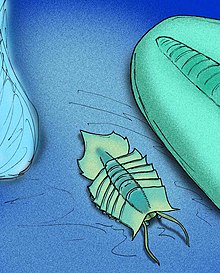Helmetia
| Helmetia Temporal range:
| |
|---|---|

| |
| Artist's rendition of Helmetia alongside Tegopelte gigas | |
| Scientific classification | |
| Domain: | Eukaryota |
| Kingdom: | Animalia |
| Phylum: | Arthropoda |
| Subphylum: | †Trilobitomorpha |
| Subclass: | †Conciliterga |
| Genus: | †Helmetia |
| Species: | †H. expansa
|
| Binomial name | |
| †Helmetia expansa Walcott, 1918
| |
Helmetia is an extinct genus of arthropod from the middle Cambrian. Its fossils have been found in the Burgess Shale of Canada and the Jince Formation of the Czech Republic.[1]
Fossils are both rare and poorly known; the genus was described by Walcott in 1918 and has not been reexamined, though it was briefly reviewed in the 1990s and has been included in a number of cladistic analyses. It has been lumped with the arachnomorphs. One analysis has resolved the Helmetiiida as a robust clade and the closest relatives of trilobites.[2]
The most complete specimen of Helmetia is 19 cm long, and has six thoracic segments. There is a head shield and a large tail shield, making the animal leaf-shaped. Unlike trilobites, the margin of the head shield is concave, ending in a spine on each corner. There is an oval structure with two spots at the anterior center of the head shield, behind which are two eyes. The whole animal is broad and flat with a thin exoskeleton. The central region shows paired muscle scars and filamentous structures interpreted as limbs. Because the head shield, thoracic segments, and tail shield are all angular in outline and end in spines, Helmetia is unstreamlined and would likely be a slow swimmer. However, the flattened body and filamentous limbs suggest a floating or swimming lifestyle.[3] It has been interpreted as a nektonic suspension feeder.[4]
References
[edit]- ^ Kordule Chlupáč (2002). "Arthropods of Burgess Shale type from the Middle Cambrian of Bohemia (Czech Republic)". Bulletin of the Czech Geological Survey. 77: 167–182.
- ^ Edgecombe, Gregory D.; Ramsköld, Lars (1999). "Relationships of Cambrian Arachnata and the Systematic Position of Trilobita". Journal of Paleontology. 73 (2): 263–287. Bibcode:1999JPal...73..263E. doi:10.1017/S0022336000027761. JSTOR 1306784. S2CID 84029615.
- ^ Canada, Royal Ontario Museum and Parks (2011-06-10). "The Burgess Shale". burgess-shale.rom.on.ca. Retrieved 2018-10-28.[permanent dead link]
- ^ CARON, J.-B. and JACKSON, D. A. 2008. Paleoecology of the Greater Phyllopod Bed community, Burgess Shale. Palaeogeography, Palaeoclimatology, Palaeoecology, 258, 222–256.
Further reading
[edit]- Stephen Jay Gould (1989). Wonderful Life: The Burgess Shale and the Nature of History. W. W. Norton & Company. Bibcode:1989wlbs.book.....G.
- Xian-Guang Hou; Richard J. Aldridge; Jan Bergström; David J. Siveter; Derek J. Siveter & Feng Xiang-Hong (2004). The Cambrian Fossils of Chengjiang, China: The Flowering of Early Animal Life. John Wiley & Sons. ISBN 978-1-4051-0673-3.
External links
[edit]- "Helmetia expansa". Burgess Shale Fossil Gallery. Virtual Museum of Canada. 2011. Archived from the original on 2020-11-12. Retrieved 2023-01-21.
- Helmetia in the Paleobiology Database




